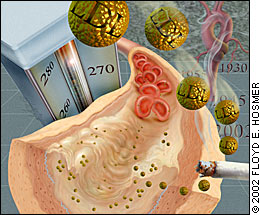
Am Fam Physician. 2002;65(5):761

The holidays are long gone, and you're moving rapidly through the new year, but many of your patients may still remember their New Year's resolutions and be wondering how to get started—and perhaps they need just a little motivation from their family physician. How often have you heard these promises from your patients during the past week? “This year, I'm going to lose weight.” “I really mean to cut down on my drinking.” “I'm going to start watching my cholesterol.” “I'm thinking about quitting smoking.” Family physicians are in an ideal position to steer patients in the right direction when they're ready to get started.
So far this year, AFP has published several articles that may provide new inspiration for physicians who want to help their patients tackle some of the major health barriers. We've made a reading list to help you get started:
This issue features the cover article “Cholesterol Treatment Guidelines Update,” by Richard S. Safeer, M.D., and Prabha S. Ugalat, M.P.H., on page 871. This article provides the third set of guidelines from the National Cholesterol Education Program, which includes revised guidelines on cholesterol management. The new guidelines stress the importance of an aggressive therapeutic approach in the treatment of hypercholesterolemia. You won't want to miss the accompanying editorial by Benjamin J. Answell, M.D., “Improvement in Current Approaches to Lipid Lowering,” on page 783.
Updated guidelines for lipid screening from the U.S. Preventive Services Task Force were published in the January 15 issue (Am Fam Physician 2002:65(2):273–6).
The subject of obesity was covered in an article entitled “Medical Care for Obese Patients: Advice for Health Care Professionals,” from the National Task Force on the Prevention and Treatment of Obesity, published in the January 1 issue (Am Fam Physician 2002;65(1):81–8). More than 60 percent of adults in the United States are overweight or obese, and the prevalence of obesity has almost doubled during the past two decades. Physicians will be caring for an increasing number of overweight and obese patients, and many of them will have multiple medical conditions. Physicians can improve care for obese patients by addressing their patients' medical and psychosocial needs regarding their ability to lose weight.
The February 1 issue featured the cover article, “Problem Drinking and Alcoholism: Diagnosis and Treatment,” by Mary-Anne Enoch, M.D., M.R.C.G.P., and David Goldman, M.D. (Am Fam Physician 2002; 65(3):441–8). Alcoholism is a common psychiatric disorder associated with considerable morbidity and mortality. Screening for problem drinking and alcoholism should be an integral part of routine health questionnaires. The article featured a handout to help patients recognize when their drinking habits may have crossed healthy boundaries.
You may also want to watch for the upcoming article “Smoking Cessation: Integration of Behavioral and Drug Therapies,” by Robert Mallin, M.D., which will appear in the March 15 issue. This article in the “Practical Therapeutics” series will describe how the five-stage transtheoretical model for readiness to change can be applied to an addictive behavior such as smoking. Combined nicotine replacement and bupropion therapy can increase the chance of successful smoking cessation. A patient information handout to help patients stop smoking will accompany the article.